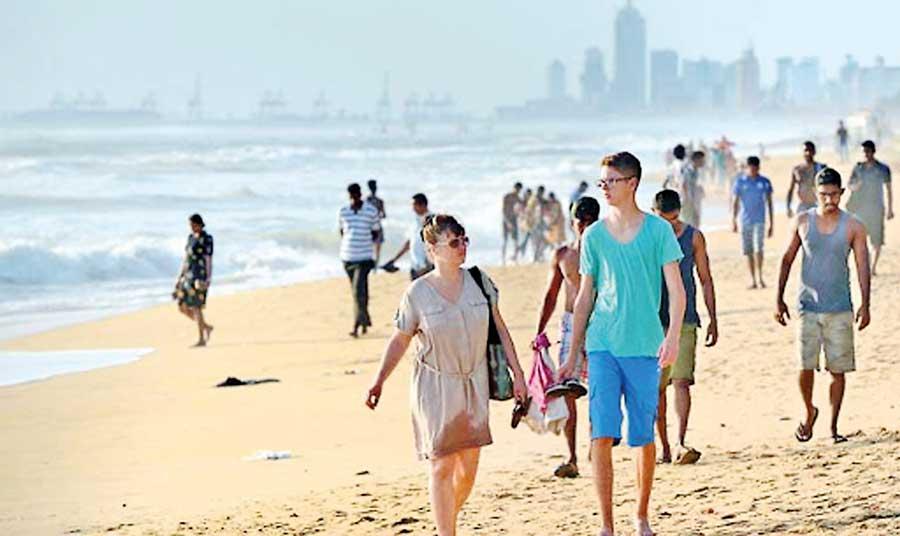11 Feb 2020 - {{hitsCtrl.values.hits}}

Several popular beaches have become crowded and it is nearly impossible to relax in the beach
 Recently emerging markets investment expert Mark Mobius said that Sri Lanka should target 10 million tourists in response to new government’s target to attract 4 million tourists, and to earn 10 billion dollars from tourism by 2025.
Recently emerging markets investment expert Mark Mobius said that Sri Lanka should target 10 million tourists in response to new government’s target to attract 4 million tourists, and to earn 10 billion dollars from tourism by 2025.
Doubling tourist arrivals, and earnings within a 5-year time frame, is a reasonable target as Sri Lanka has achieved similar growth during the period following end of civil war in 2009. However, in order to achieve 4 million tourists, Sri Lanka must ensure that there is sufficient infrastructure or enough room-stock to host such number of visitors.
Missing previous targets
Sri Lanka missed several previous targets to attract tourists. For example previous government set the target of achieving 2.5 million tourists by 2017, and 4 million tourists by 2020.
Repeated failure to achieve targets was partly due industry’s slower shift towards supply-driven approach from traditional and passive demand-driven approach. In a supply driven market, quality and quantity of room-stock as well as pricing are very important. In this respect, it is important that Sri Lanka evaluates that it has the right mix of room-stock at right price.
Will Sri Lanka have enough rooms?
According to SLTDA statistics, as at September 2019, Sri Lanka had around 24,000 hotel rooms (classified and unclassified) and 15,800 rooms from supplementary establishments (such as home-stays). Assuming, there won’t be major change in country’s tourism product offerings, and supply mix (i.e., hotel rooms vs. supplementary establishments), Sri Lanka will have to double the current room capacity by 2025 to accommodate 4 million tourists.
This means annually around 4,800 new hotel rooms have to be added to the market for the five next years. During the five year period up to 2019, average annual increase in room-stock was around 770.
Industry data shows that around 9,000 hotel rooms are under construction or awaiting commencement of construction.This brings down the additional rooms requirement to around 15,000. This translates into 300 - 400 new hotel projects. Since it takes about two years to construct a hotel, Sri Lanka will have to approve approx. one hotel project per every 2-3 working days during next 3 years to reach required hotel room target!
Although this looks a good proposition for the construction industry, mixed financial track record of the majority of post-2009 hotel projects, and due to other concerns such as high construction cost, it may not be easy to convince investors of the Sri Lanka’s business case for hotel development.
Where to develop hotels?
It is crucial to find additional locations tourist hubs as many existing hubs are facing saturation or over-tourism. Unless proper policy interventions are done, poorly planned developments will result in below optimal results as in the case of many post-2009 projects. Based on Sri Lanka’s geography and climatic condition, suitable sites for major tourist hubs are limited although smaller hubs are feasible with minimal disruption to cultural and natural eco-system. For example, there are room to develop small mountain resort hubs.
However, policy guidelines will be required to make such hubs economically and environmentally feasible. Ideally such small hubs should have smaller resorts (with maximum room restrictions) and should have strict measures to prevent over-tourism.
Another issue to consider in developing new tourist hubs is to gradually reduce over-tourism in established tourist sites/hubs. Some tourist hubs and popular tourist attractions have become so overcrowded. For example some wildlife parks, and cultural sites have become crowded.
Several popular beaches have become crowded and it is nearly impossible to relax in the beach. Some tourist cities like Kandy have become congested to a level that it has become so inconvenient for both residents and tourist alike. Therefore when developing new tourist hubs and resort sites it is essential to do so linking new cultural and nature sites in order to spread-out tourist traffic.
Further it is important to move away from developing traditional “one night stay” or transit type resorts to longer-stay resorts where a tourist could spend and enjoy certain experiences for a few days. Advancement of transport infrastructure has also made some types of accommodation such as transit type hotels redundant. Moreover the visitor preferences are shifting towards smaller hotels/resorts that offer unique experience compared to crowded mega developments.
Correct pricing and target marketing
An average tourist spends around 2,000 dollars during a holiday in Sri Lanka. This is a high figure when compared to other Asian tourist markets like Malaysia, Indonesia and Thailand. Even when compared to many European destinations, average tourist spend more money for a vacation in Sri Lanka. In a supply driven markets, price is an important factor, and Sri Lanka may need to be concerned about pricing if it is to reach a large number of tourists. An average tourist spends a couple of hundred dollars as entrance fees to tourist attractions, which appear to be excessive especially compared to facilities at some of these sites. Hotels in Sri Lanka are also comparatively overpriced.But the flexibility to adjust room rates in Sri Lanka is somewhat constrained due to high capital cost and operating cost structure.
According to tourism industry academic, Dimitros Buhalis, demand for tourism comprise of three elements. They are actual demand (or organic demand), suppressed demand and latent demand. Sri Lanka continues to enjoy growth in tourist arrivals from actual and suppressed demand since 2009. If Sri Lanka to leapfrog to the next level, Sri Lanka needs to put efforts on developing the third category of demand which is about luring visitors to specific location, experience or service at a specific time.
Sri Lanka’s tourism sector expanded rapid over the last decade. Despite several adverse operating conditions, Sri Lanka managed to emerge as a hot spot in the global tourism landscape as evident by many international accolades and endorsements such as recent naming of Sri Lanka as No I destination for Winter Travel by USA Today.
Reaching 4 million tourists is not going to be difficult for Sri Lanka, but accommodating 4 million tourists and beyond will need more planning and investment.Even at 4 million tourists, or one foreign visitor per five citizens, Sri Lanka would still be an under-tourism destination!
(The writer is an independent consultant specializing in project, venture capital and private equity [email protected])
26 Dec 2024 46 minute ago
26 Dec 2024 52 minute ago
26 Dec 2024 2 hours ago
26 Dec 2024 2 hours ago
26 Dec 2024 4 hours ago